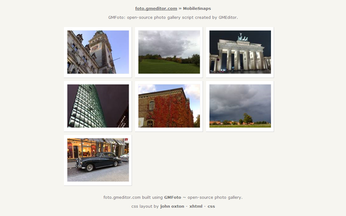Create a Web-based Photo Gallery in a Jiffy with GMFoto

Productivity Sauce
Looking for a quick and easy way to set up a Web-based photo gallery? Consider GMFoto. This application lets you create a snazzy Web-based photo album literally in a matter of minutes.
Unlike many popular photo gallery applications, GMFoto doesn't use a database back-end, so it's dead-simple to install and configure. Grab the latest version of the application and unpack the downloaded archive into a directory (e.g., gmfoto). Now open the code/code.index.php file in a text editor and replace the loveunit_com string with the name of the resulting directory (in this case, it's gmfoto). Do the same in the index.php file in the user/00000 directory. The user/00000 directory also contains the settings.php file which you can use to tweak the gallery's settings. Here you can specify a gallery name and description, keywords, a Google Analytics account ID, a gallery skin, and thumbnail sizes.
Once GMFoto is configured, move the entire gmfoto directory into the document root of your server, and copy the folders containing photos to the user/00000 directory. Point your browser to http://yourserver/gmfoto/user/00000 and behold the gallery generated by GMFoto. Note that it may take a while for GMFoto to generate thumbnails for the photos, so you may have to wait a bit for the gallery to appear in the browser.
GMFoto supports multiple users (it comes with two default user directories: 00000 and 00001). If you want to add a new user, simply clone the entire 0000 or 0001 directory and edit the index.php file as described above.
GMFoto is not the most advanced photo gallery software out there, but if you need to turn your photo collection into a slick photo album with a minimum of effort, this application will do the trick just fine.
Comments
comments powered by DisqusSubscribe to our Linux Newsletters
Find Linux and Open Source Jobs
Subscribe to our ADMIN Newsletters
Support Our Work
Linux Magazine content is made possible with support from readers like you. Please consider contributing when you’ve found an article to be beneficial.

News
-
Parrot OS Switches to KDE Plasma Desktop
Yet another distro is making the move to the KDE Plasma desktop.
-
TUXEDO Announces Gemini 17
TUXEDO Computers has released the fourth generation of its Gemini laptop with plenty of updates.
-
Two New Distros Adopt Enlightenment
MX Moksha and AV Linux 25 join ranks with Bodhi Linux and embrace the Enlightenment desktop.
-
Solus Linux 4.8 Removes Python 2
Solus Linux 4.8 has been released with the latest Linux kernel, updated desktops, and a key removal.
-
Zorin OS 18 Hits over a Million Downloads
If you doubt Linux isn't gaining popularity, you only have to look at Zorin OS's download numbers.
-
TUXEDO Computers Scraps Snapdragon X1E-Based Laptop
Due to issues with a Snapdragon CPU, TUXEDO Computers has cancelled its plans to release a laptop based on this elite hardware.
-
Debian Unleashes Debian Libre Live
Debian Libre Live keeps your machine free of proprietary software.
-
Valve Announces Pending Release of Steam Machine
Shout it to the heavens: Steam Machine, powered by Linux, is set to arrive in 2026.
-
Happy Birthday, ADMIN Magazine!
ADMIN is celebrating its 15th anniversary with issue #90.
-
Another Linux Malware Discovered
Russian hackers use Hyper-V to hide malware within Linux virtual machines.


I followed the instructions...
Where exactly do the pictures need to be, and what else could be preventing it from working? Is there some log file I can check to see what is going on... Other than that I don't know what other information I can give you....
Dave
Re: Name??
Name??